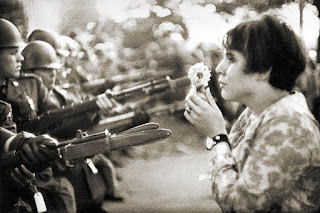Posted by Thomas Scarbrough
The human sphere is exceedingly complex – and inscrutable. It is one thing for us to trace relations in our world, as by nature we all do – quite another to know how others trace relations in this world. While our physical world is more or less open to view, this is not the case with worlds which exist inside other people's minds – people who further hide behind semiotic codes: the raising of an eyebrow, for instance, or a laugh, or an utterance.
A million examples could not speak as loudly as the fact that we have a problem in principle. Like the chess novice who randomly inserts a move into the grand master's game, as soon as we introduce others into the picture, there is a quantum leap in complexity. Small wonder that we find it easier to speak about our world in 'factual' terms than in human terms.
Further, in the human sphere we experience frequent reversals and uncertainties – war, famine, and disease, among many other things – while through the natural sciences we are presented with continual novelty and advance. In comparison with the 'factual' sphere, the human sphere is a quagmire. This leads to a spontaneous privileging of the natural sciences.
We come to see the natural sciences as indicating values, where strictly they do not – and cannot. That is, we consider that they give us direction as to how we should behave. And so, economic indicators determine our responses to the economy, clinical indicators determine our responses to a 'clinical situation' (that is, to a patient), environmental indicators determine our responses to the state of our environment, and so on.
Jean-François Lyotard proposed that efficiency, above all, provides us with legitimation for human action today. If we can only do something more efficiently – or more profitably – then we have found a reason to do it. In fact society in its entirety, Lyotard considered, has become a system which must aim for efficient functioning, to the exclusion of its less efficient elements.This is the way in which, subtly, as if by stealth – we have come fill a great value vacuum in our world with pseudo values, borrowed from the realm of fact. Philosophically, this cannot be done – yet it is done – and it happens like this:
The human sphere is exceedingly complex – and inscrutable. It is one thing for us to trace relations in our world, as by nature we all do – quite another to know how others trace relations in this world. While our physical world is more or less open to view, this is not the case with worlds which exist inside other people's minds – people who further hide behind semiotic codes: the raising of an eyebrow, for instance, or a laugh, or an utterance.
A million examples could not speak as loudly as the fact that we have a problem in principle. Like the chess novice who randomly inserts a move into the grand master's game, as soon as we introduce others into the picture, there is a quantum leap in complexity. Small wonder that we find it easier to speak about our world in 'factual' terms than in human terms.
Further, in the human sphere we experience frequent reversals and uncertainties – war, famine, and disease, among many other things – while through the natural sciences we are presented with continual novelty and advance. In comparison with the 'factual' sphere, the human sphere is a quagmire. This leads to a spontaneous privileging of the natural sciences.
We come to see the natural sciences as indicating values, where strictly they do not – and cannot. That is, we consider that they give us direction as to how we should behave. And so, economic indicators determine our responses to the economy, clinical indicators determine our responses to a 'clinical situation' (that is, to a patient), environmental indicators determine our responses to the state of our environment, and so on.
Yet philosophers know that we are unable, through facts, to arrive at any values. We call it the fact-value distinction, and it leaves us with only two logical extremes: logical positivism on the one hand, or ethical intuitionism on the other. That is, either we cannot speak about values at all, or we must speak about them in the face of our severance from the facts.
We automatically, impulsively, instinctively react to graphs, charts, statistics, imagining that they give us reason to act. Yet this is illusory. While the natural sciences might seem to point us somewhere, in terms of value, strictly they do not, and cannot. It is fact seeking to show us value.
Thus we calculate, tabulate, and assess things, writes sociologist James Aho, on the basis of 'accounting calculations', the value of which has no true basis. Such calculations have under the banner of efficiency come to colonise themselves in virtually every institutional realm of modern society – while it is and has to be a philosophical mistake.
Of course, efficiency has positive aspects. We receive efficient service, we design an efficient machine, or we have an efficient economy. This alone raises the status of efficiency in our thinking. However, in the context of this discussion, where efficiency represents legitimation for human action, it has no proper place.
The idea of such efficiency has introduced us to a life which many of us would not have imagined as children: we are both processed and we process others, on the basis of data sets – while organic fields of interest such as farming, building, nursing, even sports, have been reduced to something increasingly resembling paint-by-numbers. It is called 'increased objectification'.
With the advance of efficiency as a motive for action, we have come to experience, too, widespread alienation today: feelings of powerlessness, normlessness, meaninglessness, and social isolation, which did not exist in former times. Karl Marx considered that we have been overtaken by commodity fetishism, where the devaluation of the human sphere is proportional to the over-valuation of things.
Theologian Samuel Henry Goodwin summed it up: 'We are just a number.' Through pseudo values, borrowed from the realm of fact, we are dehumanised. In fact, this must be the case as long as we take numerate approaches to human affairs on the basis that they are 'indicated' by facts. Cold fact encroaches on the complex and subtle relations which are represented by the human sciences – in fact, by life as it is lived.
We automatically, impulsively, instinctively react to graphs, charts, statistics, imagining that they give us reason to act. Yet this is illusory. While the natural sciences might seem to point us somewhere, in terms of value, strictly they do not, and cannot. It is fact seeking to show us value.
Thus we calculate, tabulate, and assess things, writes sociologist James Aho, on the basis of 'accounting calculations', the value of which has no true basis. Such calculations have under the banner of efficiency come to colonise themselves in virtually every institutional realm of modern society – while it is and has to be a philosophical mistake.
Of course, efficiency has positive aspects. We receive efficient service, we design an efficient machine, or we have an efficient economy. This alone raises the status of efficiency in our thinking. However, in the context of this discussion, where efficiency represents legitimation for human action, it has no proper place.
The idea of such efficiency has introduced us to a life which many of us would not have imagined as children: we are both processed and we process others, on the basis of data sets – while organic fields of interest such as farming, building, nursing, even sports, have been reduced to something increasingly resembling paint-by-numbers. It is called 'increased objectification'.
With the advance of efficiency as a motive for action, we have come to experience, too, widespread alienation today: feelings of powerlessness, normlessness, meaninglessness, and social isolation, which did not exist in former times. Karl Marx considered that we have been overtaken by commodity fetishism, where the devaluation of the human sphere is proportional to the over-valuation of things.
Theologian Samuel Henry Goodwin summed it up: 'We are just a number.' Through pseudo values, borrowed from the realm of fact, we are dehumanised. In fact, this must be the case as long as we take numerate approaches to human affairs on the basis that they are 'indicated' by facts. Cold fact encroaches on the complex and subtle relations which are represented by the human sciences – in fact, by life as it is lived.










